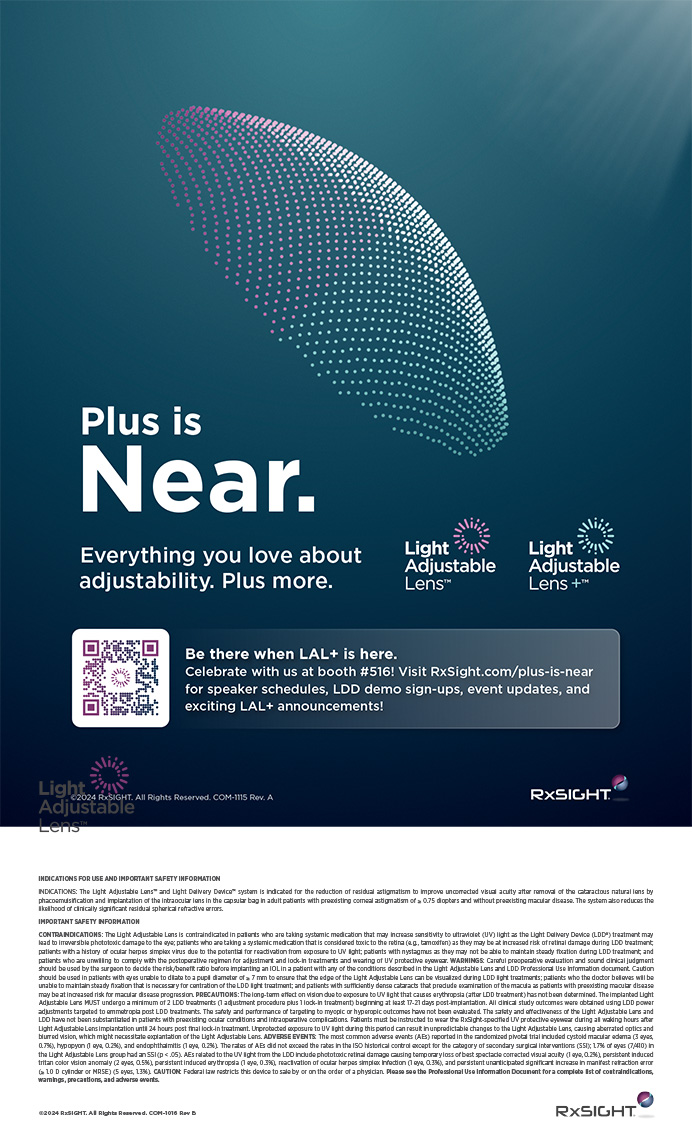Up Front | Nov 2005
Contrast 101
The clinical relevance of contrast and luminance.
Lee T. Nordan, MD
The issue of corneal asphericity after keratorefractive surgery and attempts to correct presbyopia by means of a bifocal IOL or corneal procedure have led ophthalmologists to discuss the concept of contrast. What is contrast, and why is it so important? This and several future editions of the Nordan Perspective will focus on contrast and its clinical importance.
DEFINING TERMS
Contrast is the essence of vision, that is, the ability to sense a dividing line between forms. Any object that is within the field of view and is not completely monochromatic must possess differing levels of contrast in order for someone to perceive its shape.
Contrast is defined by the following equation.
contrast =
luminance (background) - luminance (object)
luminance (background) + luminance (object)
The term luminance refers to the amount of light that is reflected from a given surface. On the idealized Snellen chart, the letters are black with a luminance of zero, and the background is white with a luminance equal to 100. Using the aforementioned formula, the calculated contrast is: (100 - 0)/(100 + 0) = 100%.
In the real world of Snellen acuity testing, the luminance of the black letters is approximately 4%, and the luminance of the white background is about 97%. These values yield a contrast for the standard Snellen chart of (97 - 4)/(97 + 4) = 92%.
INTRIGUING ISSUE
Which affects contrast more: increasing the luminance of the object or decreasing the luminance of the background (Figure 1)? For the purpose of illustration, the following examples assume a starting point of 60%, created by a background luminance of 80% and an object luminance of 20%: contrast = (80 - 20)/(80 + 20) = 60%. The luminance of the background decreases by 50% (Example 1), and then the luminance of the object increases by 50% (Example 2).
Example 1. Contrast = (40 - 20)/(40 + 20) = 33%
Example 2. (80 - 30)/(80 + 30) = 45%
In this basic comparison, increasing the luminance of the object reduces the contrast less than a proportional decrease in the luminance of the background.
CLINICAL RELEVANCE
As light reflected from a target enters the eye, it is either focused on the macula, scattered as unfocused light (glare), absorbed (nuclear sclerotic cataract), or blocked (corneal scar). The glare caused by a posterior subcapsular cataract is more deleterious to vision than mild-to-moderate nuclear sclerosis. The reason is that glare showers the macula with light and effectively increases the luminance of both the object and the background. Slightly decreasing the luminance of the background, as might occur with a 2+ nuclear sclerotic cataract, does not affect contrast nearly as seriously.
On the other hand, the advantage of blending the target into the background is appreciated by those who are familiar with camouflage. These individuals attempt to make the object equal in luminance to the background.
Glare may be caused by corneal asphericity after keratorefractive surgery and by the refracting power of a bifocal IOL that is not in focus for a given target. The pupil plays an important role in determining the advantages of the depth of field gained through corneal asphericity versus the loss of vision caused by the lack of focus. The -2.00D eye of a patient whose keratorefractive surgery produces minimal corneal asphericity has excellent vision at night, but a patient with a -10.00D eye preoperatively will invariably experience halos at night (larger pupil), no matter how accurate the result.
For all of these reasons, a Snellen-style test that uses letters of varying contrast is important if clinicians wish to appraise a patient's functional vision accurately. The Snellen test measures only high contrast, and it was designed to screen for refractive error. In truth, the chart has served us well as a diagnostic device for many types of ocular pathology, because most significant conditions decrease visual acuity. Now that refractive surgery is so common, however, a testing method that can discriminate between the various results of refractive procedures is crucial. In addition, a contrast acuity test will allow ophthalmologists easily to compare the efficacy of competing methods of refractive surgery and of presbyopic correction.
CONCLUSION
Another topic for discussion and change, in my opinion, is the reporting of contrast sensitivity values. Contrast sensitivity charts cannot be compared effectively in the clinical setting, and they are not based upon clinically significant chores and situations encountered by the patient. In next month's column, I will propose a contrast acuity/visual acuity chart and discuss a clinically significant way to report and compare contrast sensitivity findings.
Lee T. Nordan, MD, is a technology consultant for Vision Membrane Technologies, Inc., in Carlsbad, California. Dr. Nordan may be reached at (760) 431-1846; laserltn@aol.com.


